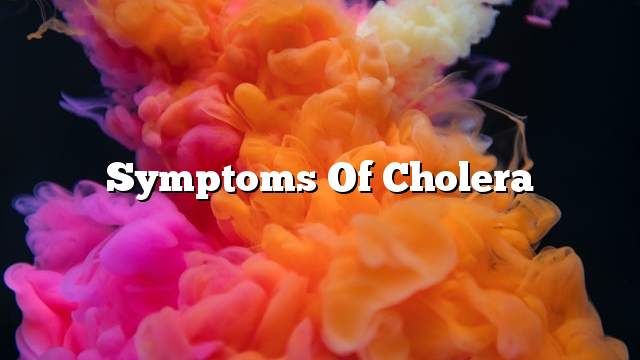Cholera
Cholera is an infectious disease and is transmitted through a bacteria called the vibrio cholera through the food and drink contaminated by the faeces of people infected with the disease. Cholera leads to very severe diarrhea. The cholera treatment is based on the provision of fluids to the patient, while the most important method of prevention is the sterilization of water used for drinking.
Cholera Symptoms
Cholera does not appear in most people who develop it, but a quarter of people with cholera have mild to moderate symptoms, and only about 5 percent of people with cholera have severe symptoms. The common symptoms of cholera are as follows:
- In severe cases, the patient suffers from a very severe diarrhea that tends to be white, smells like fish, and very rarely accompanied by mucus and blood. The number of times the bathroom is used is 10-20 times a day, Very fluid, salts, and various elements present in the body.
- Vomiting and high temperature, but it is not very high; vomiting occurs throughout the day, and the number of vomiting from (5-7) times a day, and includes anything that is consumed or eaten by the patient.
- The patient also suffers from abdominal pain. This pain occurs in all areas of the abdomen and is not concentrated in a specific area. It decreases every time the patient goes to the bathroom and then returns, often described as a moderate pain.
- The loss of fluids leads to the patient suffering from dehydration; the heartbeat increases, the breath accelerates, the patient suffers from a severe thirst for a large amount of fluid, and dryness of the skin; when the skin folds back to normal, In less than twenty-four hours.
- A defect in blood chemistry and salts leads to muscle and joint pain, as well as a shock of blood volume that leads to loss of consciousness or death within a few hours. These symptoms should not be underestimated.
- In children, the symptoms are similar to adults, but it may take a little longer for these signs to appear. Usually, a child’s dehydration is accompanied by a decrease in blood sugar, leading to fainting and seizures.
Causes of cholera
This disease causes bacteria called fibrio cholera, also called cholera, usually found in food or contaminated water, and include the following:
- Drinking water contaminated or blended with sewage. Contaminated water is associated with the transmission of diseases such as cholera, diarrhea, hepatitis A, poliomyelitis and typhoid.
- Vegetables grown from water containing human waste.
- Raw fish or seafood extracted from water contaminated with sewage.
Prevention of cholera
Although there is a vaccine against cholera, the Centers for Disease Control (CDC) and the World Health Organization (WHO) do not usually recommend it because its doses do not protect against the disease forever. Its effect takes only a few months to two years. Protect himself and his family using water that is completely free of germs, water that has been chemically cleared, or bottled water. Also, be sure to use boiling water, or chemically disinfected before use in the following:
- Drinking.
- preparing food.
- Making ice.
- Daily use of the individual, such as cleaning the teeth, or washing the face and hands.
- Wash dishwashers and utensils that are used to eat or prepare food.
- Wash fruits and vegetables.
The patient should also follow several tips to prevent cholera, including:
- Boil water for 1 to 3 minutes at high temperature, or use commercial chemical disinfectant.
- Avoid raw foods such as raw fruits and vegetables, milk, non-pasteurized milk, raw or uncooked meat, avoid eating fish caught in tropical reefs that may be contaminated with sewage.
Treatment of cholera
If the patient is suffering from severe diarrhea and vomiting, especially after eating raw fish and oysters in particular, he must seek medical help immediately; although cholera can be treated quickly, care must be taken of its symptoms; Quickly, and then the injured must expedite the treatment and follow the following:
- Drink water and refreshments; they are the mainstay of cholera, depending on how severe diarrhea is; oral or intravenous treatment to compensate the body for lost fluids.
- Antibiotics that kill bacteria are not part of emergency treatment in mild cases, but can reduce the duration of diarrhea by half, and also reduce the secretion of bacteria, which helps prevent the spread of the disease.
- Take antidepressants, such as vomiting drugs, diarrhea, and antihypertensives.
